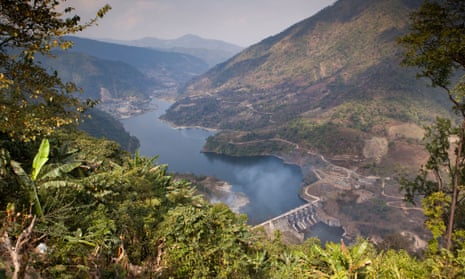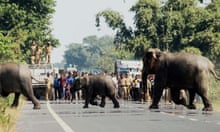Six years ago, former Indian prime minister Manmohan Singh laid the foundation stone for the 3,000MW Dibang multipurpose dam project. The dam, to be built across the Dibang river, in the north-eastern state of Arunachal Pradesh, will be the country’s largest. The state plans to build more than 160 dams in the coming years.
Dibang dam will not only generate power but supposedly control floods in the plains of neighbouring Assam state. The dam’s reservoir was estimated to submerge 5,000 hectares (12,000 acres) of dense forests along the Dibang river valley. The forest advisory committee (FAC), which examines the impact of infrastructure projects on wilderness areas, was appalled and rejected it.
For a project so large, the environmental impact assessment (EIA) failed to assess critical components of the project and was widely criticised for inadequately predicting the dam’s effects on the environment. Its evaluation of impacts on wildlife is a farce. The authors of the document list creatures not found in that area, such as Himalayan tahr, and concocted species not known to exist anywhere in the world, such as brown pied hornbill. Of the ones they could have got right, they mangled the names, referring to flycatchers as ‘flying catchers’ and fantail as ‘fanter’.
In his scathing critique, Anwaruddin Choudhury, an expert on the wildlife of north-east India, sarcastically concluded the EIA makes a case for the project to be shelved, as Dibang was the only place in the world “with these specialities!” Despite listing these amazing creatures, the EIA goes on to say “no major wildlife is observed”.
In a similar vein, the document claims only 301 people will be affected by the dam. Authorities must be puzzled that a project with so few affected people should be opposed by so many. Protests by local people began soon after the inaugural stone was laid in 2008. Since then large crowds have disrupted public hearings. On 5 October 2011, police fired on one such mass demonstration, injuring 10 people. Regional authorities branded anti-dam protestors as Maoist rebels, further angering them.
In Arunachal Pradesh, the Idu Mishmi and Adi tribes will be the most affected. They fear loss of grazing land, fishing grounds, and lack of safety of the dam in a seismically volatile zone. Additionally, they are concerned that the large number of workers needed to build the dam will overwhelm their cultural identity and their lands.
When the FAC first rejected the project in June 2013, it said the “ecological, environmental and social costs of diversion of such a vast track of forest land, which is a major source of livelihood of the tribal population of the state, will far outweigh the benefits likely to accrue from the project”.
Some of the grassland-covered river islands in the Dibang river are the prime habitat of the critically endangered Bengal florican. The ministry’s recovery plan for the bird species recommends the area be designated as a national park.
Neeraj Vagholikar, an environmentalist familiar with the case, who works for NGO Kalpavriksh, lists the concerns of people downstream in Assam: loss of fisheries, loss of agricultural land on river islands, increased vulnerability to floods caused by removal of boulders from riverbeds for dam construction, sudden release of water from the reservoir in the monsoons, and safety of the dam in a geologically fragile and seismically active region.
Under public pressure, Assam chief minister Tarun Gogoi told prime minister Narendra Modi in July this year, “We urge that all hydro electric projects be taken up only after consideration of dam safety, flood moderation and downstream impact mitigation measures in consultation with government of Assam.”
Arunachal Pradesh resubmitted the proposal in February 2014, dropping the height of the dam from 288 metres to 278 metres and saving 1,100 acres of forest. The FAC rejected it again in April 2014.
Prakash Javadekar’s ministry of environment and forests also rejected the proposal on 28 August 2014, and cited these reasons in its letter: “[The] proposed area is very rich in biodiversity, sensitive ecosystem being at the edge of hills and flood plains and having large number of endemic and endangered flora and fauna, etc. Moreover, such project is most likely to have considerable downstream impact including impact on the Dibru-Saikhowa NP [national park] in Assam which is yet to be studied.”
That ought to have put paid to the dam project. Instead, the prime minister’s principal secretary revived it in early September.
This time it sailed through the clearance process. At the time of writing, the minutes of the FAC meeting granting approval have not been made public, and the final height of the dam is still unconfirmed. Anti-dam activists suspect the height of the dam may be lower by 20 metres, and the dam is likely to submerge 4,300 hectares (10,586 acres) of forest.
Javadekar has repeatedly stated he supported development without destruction of environment. But it’s just a matter of days before he affixes his seal of approval to the dam. The FAC’s previous concerns for the area’s biodiversity and the lack of studies of the impact in Assam were brushed aside. A project that claims to control flooding in Assam has not conducted one public meeting in that state nor was the chief minister’s demand for consultation acknowledged. The ministry’s own concerns about the impact on Dibru-Saikhowa national park remain unaddressed. This is the latest in a series of moves made by the government to push large projects at the cost of the environment.
When he was a prime ministerial candidate, on 22 February 2014, Modi had said in a speech at Pasighat, Arunachal Pradesh: “I know that the people of the state are against the building of big dams, and I do understand their sentiments. We can still tap those potentials with proper scientific technology and small dams, besides using solar energy to supplement them.” Either he had changed his mind in six months, or he never meant what he said then.
However, forcing these approvals through may not make an iota of difference. The 2,000MW lower Subansiri hydroelectric power project got all its clearances, and yet after spending over £500m, the project was brought to a halt in December 2011. The largest anti-dam people’s movement, “unprecedented in India’s hydropower history,” refuses to allow dam construction.
Activists believe the buildup of a massive opposition in Arunachal Pradesh and Assam may render the Dibang dam a non-starter too.


